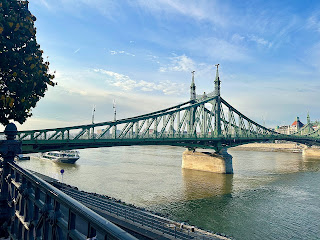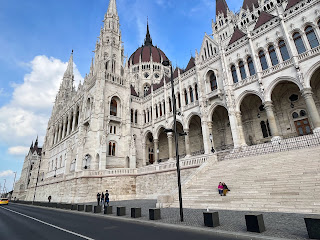10/8/22-10/9/22: Budapest, Hungary
Weather: sunny, cool to warm
Tours: Welcome aboard tour of neighborhood around docks on the Peste side
Castle Hill District Hike
Exploration on our own of the Peste side including Parliament Building and area, St. Stephan's Basilica, pedestrian shopping/dining area
Note: You can click on any picture to make it larger.
After boarding the longboat after the 7-hour bus ride through The Czech Republic, Slovakia, and Hungary, we went out on a short informational walk of the area near the boat dock. The guide was very funny and gave us a ton of information. We then did a quick look through some of the public areas of the boat, met up in the lounge for a drink and the welcome talk, and then had our first dinner in the Restaurant. There are 180 guests on board and everyone that we’ve met has been delightful.
Tomorrow Al, Erin, and I have a morning hike of the Castle Hill district. So it’s off to bed!
In Hungary the public restrooms require payment. You put a one Euro coin in the slot and the turnstile lets you through. I thought it was hilarious. I will say, the restrooms were spotless, well appointed, and did not smell at all 😁
Outside of the Central Market, a huge farmer’s market open every day except Sunday. Of course, we’ll be touring Budapest on Sunday so we don’t get to see it open 😕.
A popular product of Hungary is paprika. It’s for sale everywhere.
Pedestrian walkway in a retail/dining area. No cars allowed!
First dinner. Food was excellent. Off to a great start!
10/9/22: This was a big picture day! We did a hike of the Castle District, returned to the boat for lunch, then went out again to explore on our own. We returned in time for the boat’s departure at 6:15 for Vienna, Austria. We logged over 9 miles, 22,000+ steps!
The Liberty Bridge is the shortest bridge in Budapest's center. Initially built as part of the Millennium World Exhibition at the end of the 19th century, the bridge features art nouveau design, mythological sculptures and the country's coat of arms adorned on its side.
The northeastern house contains a museum on the bridges of Budapest. The bridge was the first in the city to be rebuilt after suffering heavy damage during World War II.
The statuette on the bridge represents Emperor Franz Joseph with his legendary mustache, arms crossed and military shako hat on his knees, sitting on a hammock that hangs from two padlocks. He's looking very thoughtful; maybe he's reflecting on the last rivet of this beautiful bridge, which he hammered down himself.
The Liberty Statue
It was first erected in 1947 in remembrance of the Soviet liberation of Hungary during World War II, which ended the occupation by Nazi Germany. Its location upon Gellért Hill makes it a prominent feature of Budapest's cityscape. The 14 m tall bronze statue stands atop a 26 m pedestal and holds a palm leaf. Two smaller statues are also present around the base, but the original monument consisted of two more originally that have since been removed from the site and relocated to Statue Park.
At the time of the monument's construction, the defeat of Axis forces by the Red Army was officially proclaimed “liberation”—leading to the original inscription upon the memorial To the memory of the liberating Soviet heroes [erected by] the grateful Hungarian people [in] 1945". Over the following years, public sentiment toward the Soviets decreased to the point of revolution, which was attempted and temporarily succeeded in 1956 and subsequently damaged some portions of the monument. After the 1989 transition from communist rule to democracy, the inscription was modified to read: "To the memory of those all who sacrificed their lives for the independence, freedom, and prosperity of Hungary". The Russian-language version of the tribute was removed in its entirety
The Cave Church in Budapest is inspired by Our Lady of Lourdes in France, built into the rocks and caves of the Gellért Hill. The church was established by Pauline monks. One hundred and fifty years after Joseph II banned the religious order from Hungary, fifteen monks that were exiled in Poland returned to Budapest and to the Cave Church. Finally, the monks were arrested during the Communist regime and the church was closed. After the departure of the Communist regime, it was reopened and still in use today.
Buda Castle Grand Bazaar
Buda Castle Royal gardens leading up to the escalator/elevator to the top! Buda Castle is the historical castle and palace complex of the Hungarian Kings in Budapest. It was first completed in 1265, although the massive Baroque palace today occupying most of the site was built between 1749 and 1769. The complex in the past was referred to as either the Royal Palace or the Royal Castle.
The Széchenyi Chain Bridge is a chain bridge that spans the River Danube between Buda and Pest, the western and eastern sides of Budapest, the capital of Hungary. Designed by English engineer William Tierney Clark and built by Scottish engineer Adam Clark, it was the first permanent bridge across the Danube in Hungary. It was opened in 1849. It is anchored on the Pest side of the river to Széchenyi (formerly Roosevelt) Square, adjacent to the Gresham Palace and the Hungarian Academy of Sciences, and on the Buda side to Adam Clark Square, near the Zero Kilometre Stone and the lower end of the Castle Hill Funicular, leading to Buda Castle.
TheChain Bridge is also featured often in the television show FBI International.
Matthias Fountain is a monumental fountain group on the western forecourt of Buda Castle. Alajos Stróbl's Neo-Baroque masterpiece is 0ne of the most frequently photographed landmarks in the Hungarian capital. It is also referred to as the Trevi Fountain of Budapest.
Built in 1893, by Zala György, this bronze statue celebrates the freedom fighters, who fought, and in many cases also died, in one of the most important battles of The Independence War - the battle at the Buda Castle in 1848. The statue stands close to the Fisherman's Bastion. Although it is relatively small and inconspicuous, it is quite popular with the tourists. Dedicated to anonymous heroes, the statue's banner reads "Freedom or Death."
Local handicrafts
The Church of the Assumption of the Buda Castle (Hungarian: Nagyboldogasszony-templom), more commonly known as the Matthias Church (Hungarian: Mátyás-templom), more rarely the Coronation Church of Buda, is a Roman Catholic church located in the Holy Trinity Square, Budapest, Hungary, in front of the Fisherman's Bastion at the heart of Buda's Castle District. According to church tradition, it was originally built in Romanesque style in 1015, although few references exist.[2] The current building was constructed in the florid late Gothic style in the second half of the 14th century and was extensively restored in the late 19th century. It was the second largest church of medieval Buda and the seventh largest church of the medieval Hungarian Kingdom.
It is a historic building with an important history. Two Kings of Hungary were crowned within its walls: Franz Joseph I of Hungary and Elisabeth, and Charles IV of Hungary and Zita of Bourbon-Parma.
The church was also the location of the "Marian Miracle" of Buda. In 1686, during the siege of Buda city by the Holy League, a wall of the church - used as a mosque by the Ottoman occupiers of the city - collapsed due to cannon fire. It turned out that an old votive Madonna statue was hidden behind the wall. As the sculpture of the Virgin Mary appeared before the praying Muslims, the morale of the Muslim garrison collapsed and the city fell on the same day.
The statue of Saint Stephen has been standing in Buda Castle next to the Fisherman's Bastion for 115 years. Although the founding king of Hungary has always been highly respected in the country, the great work of Alajos Strobl was completed slowly. The first statue of King Stephen in Budapest was inaugurated in 1906 next to Matthias Church almost 40 years after it was first planned.
The Fisherman’s Bastion was built between 1895 and 1902 as part of the series of developments that were to celebrate the 1000th birthday of the Hungarian state. Consequently, the Bastion was inspired by the architectural style of the early medieval times (Neo-Romanesque) approx. the year 1000, when the first Hungarian king started his rule. What is more, the 7 towers of the Halaszbastya features the 7 Hungarian chieftains who had led their tribes to the present day Hungary to settle down in 895, and the Statue of St Stephen (1906), the first Hungarian king (1000-1038). In short, it is a historical monument for the millennial Hungary.
The Hungarian Parliament Building is the seat of the National Assembly of Hungary, a notable landmark of Hungary, and a popular tourist destination in Budapest. It is situated on Kossuth Square in the Pest side of the city, on the eastern bank of the Danube. It was designed by Hungarian architect Imre Steindl in neo-Gothic style and opened in 1902.[6] It has been the largest building in Hungary since its completion. Construction was started in 1885, and the building was inaugurated on the presumed 1,000th anniversary of the country in 1896. The keys to the building being handed over in 1902,[9] however, It was not fully completed until 1904.[10] The architect of the building first went blind and then later, died before its completion.
Fisherman's Bastion is one of the best known monuments in Budapest, located near the Buda Castle, in the 1st district of Budapest. It is one of the most important tourist attractions due to the unique panorama of Budapest from the Neo-Romanesque lookout terraces. The Fishermen's Bastion's main façade, parallel to the Danube, is approximately 140 meters long, of which the southern aisle is about 40 meters long, the north is 65 meters long, and the ornate central parapet is 35 meters long.
Detailed sculptures atop the building that housed Budapest's Museum of Ethnology until its new home was completed in 2021.The Museum of Ethnology houses a splendid permanent collection on Hungarian traditional culture as well as various temporary exhibitions. Through its varied collection, the museum depicts the country's traditional culture and its citizens' way of life, including the different ethnic groups that existed in Hungary. The museum recreates everyday Hungarian life from the end of the 18th century until World War I.
Erin and I sitting on the front steps of the Parliament building for a sense of scale.
Closeup of one of the towers of the Parliament building. Unfortunately we were there on a weekend so we were unable to get tickets for a tour of the building. It's said to be amazing!
On the banks of the Danube River, just in front of the Hungarian Parliament Building, stand 60 pairs of iron shoes pointed towards the river. Poignant in their simplicity, a tragic story lies behind this memorial to the hundreds who lost their lives as a result of the atrocities committed by Budapest's Arrow Cross militiamen during the Second World War. The story is extremely moving and can be read here:
I really urge everyone to take the time to read it. It is just one of many tiny chunks of history that most people never know.
Erin is posing in front of St. Stephen's Basilica, a Roman Catholic basilica in Budapest. It is named in honor of Stephen, the first king of Hungary, c.975-1038, whose right hand is housed in the reliquary. It was the sixth largest church building in Hungary before 1920. Today it is the third largest church building in present-day Hungary.
Back on the boat, it was time to set sail up the Danube River to Vienna, Austria. So far, we're having an excellent adventure!




























No comments:
Post a Comment